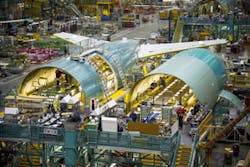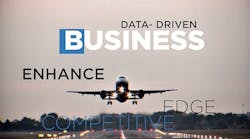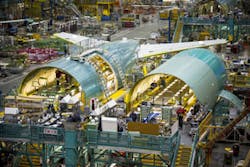Boeing transforms into data-driven business; data powers innovation and integration
Teradata PARTNERS Conference, Atlanta. The Boeing Company executives and engineers are tapping into value of data, using data-management and -analytics hardware and software, to drive product development and integration, as well as strengthen their competitive edge with enhanced, fact-based decision-making.
Boeing, manufacturer of commercial and military aircraft and the prime contractor for the International Space Station (ISS), is an aerospace pioneer with a long, 100-year history; yet, company managers are not resting on their laurels, instead they have transformed the once manufacturing- and product-centric company into a data-driven business in which valuable insights gleaned from data analytics power operations and innovations – supporting the company’s overarching vision: “What Others Dream. We do.”
“Boeing is an elite member of the innovation club,” according to representatives as Teradata, a provider of end-to-end solutions and services in data warehousing and big data and analytics in Dayton, Ohio.
Boeing officials and engineers opted to organize and analyze the company’s data, applying data management and analytics tools from Teradata, and to take actions based on insights gleaned from that data that would help them achieve their strategic vision. Boeing transformed into, and now operates as, a fact-based, data-driven culture.
“Overall Boeing was looking for one source of the truth to provide an ecosystem that allowed people to get better insights from the information, that will allow them to utilize a self-service model, and provide better answers at a higher quality with less effort,” explains Howard Alexander, director of business and supply chain systems at Boeing.
Supply chain
One goal was to provide self-service business intelligence (BI) to 20,000 internal and external users in company-wide divisions (human resources, finance, etc.) and the global supply chain through an integrated data warehouse. In doing so, Boeing information technology (IT) and business specialists had to find common definitions across business units and transform the systems infrastructure, which included consolidating hundreds of data mart. (A data mart is the access layer of the data warehouse environment used to provide data to the user; data marts are connected to and subsets of the data warehouse, a central repository.)
“One focus area has been, from the standpoint of value of integrated data, in the finance area. The key there, is that the finance professional has a seat at the table, and is more than just reporting what has happened; actually involved in helping drive the right decisions, bringing to the table insights that can help management make decisions that are going to gain a better result,” Alexander explains.
“The analytics and the business intelligence has been built around keeping them away from having to do a lot of searching for data, massaging of data, more about spending more time understanding what the data is telling them and understanding what assumptions can be derived from what they’re looking at,” Alexander says. “That’s a perfect example of where we have been able to provide a framework that has helped an organization move toward what they consider a business imperative.”
That data-based foundation enables what Alexander calls a “community approach to analytics” whereby user-friendly discovery and analysis tools empower Boeing users to solve their own problems and answer their own questions before data latency rendered the questions null. With a data-analytics infrastructure firmly in place, Boeing businesses can “solve possible problems before they become problems. Business users spend their time looking for better outcomes,” a Teradata representative affirms.
Teradata’s Unified Data Architecture enables Boeing to leverage its technology infrastructure to get the most it can holistically. Teradata Unified Data Architecture allows Boeing to meet objectives for cost performance and power the business intelligence analytic needs, Alexander says.
Black boxes
Using data from sources as diverse as radio-frequency identification (RFID) tags and airplane “black boxes” to drive timely decisions at a massive scale demands new approaches. Boeing officials, including subject-matter experts, business personnel, and data scientists/specialists, partnered with Teradata to devise and institute that innovative approach.
Boeing's sensor data pipeline supports high-value analytics with the use of parallel databases, Hadoop, and Teradata QueryGrid, which connects Teradata and Hadoop systems enabling seamless multi-system analytics on a massive scale. Temporal SQL solves time alignment, latency and scale challenges, enabling interactive analytics that were previously impossible, officials describe.
Teradata's native temporal SQL using normalization in both storage and during query processing resulted in dramatic game-changing improvements, affirms Ian Willson, technical fellow and chief architect of Analytics and Information Management Services (AIMS) in Boeing IT. Data storage achieved lossless compression 78x better than industry norms, while analytics ran up to 3,453x faster with scalability to trillions of rows (fleet or airplane level).
“We’re definitely a deeply data-driven business, from the data that’s coming from our products, our airplanes, and other products, from the data that we use to manage our business, it is about the information, and it’s going be the key differentiator in the future, as we develop fairly hot, complex systems that produce a tremendous amount of data, that we can use to make the products better, and also serve the mission of our customers better,” Alexander summarizes.
Boeing is the world's largest aerospace company and a leading manufacturer of commercial jetliners and defense, space and security systems. A top U.S. exporter, the company supports airlines and U.S. and allied government customers in 150 countries. Boeing products and tailored services include commercial and military aircraft, satellites, weapons, electronic and defense systems, launch systems, advanced information and communication systems, and performance-based logistics and training.
Howard Alexander, Director, Business Systems and Supply Chain Systems, Data Warehousing, The Boeing Company
Howard Alexander is the Director Business Systems and Supply Chain Systems Data Warehousing for The Boeing Company. Alexander is responsible for technical strategy, IT operations, and Analytic tool support for Finance, Human Resources, and Supply Chain Data Warehousing. Alexander completed a degree in Information Systems and a MBA (Finance and Marketing) from Cal State and Loyola Marymount University respectively.
Ian Willson, AIMS Chief Architect, Technical Fellow, The Boeing Company
Ian Willson is a Boeing Technical Fellow and Chief Architect of Analytics and Information Management Services (AIMS) in Boeing IT. Ian provides technical vision and oversees the technical stack. A key focus is developing parallel data analytics methods to integrate aircraft sensor data and factory RFID data with Boeing’s existing Teradata EDW. Ian’s temporal EDW design for real-time Bill-of-Material navigation was granted US patents in 2012 and 2014, influenced the ANSI SQL standard, and was adopted by Teradata’s in their native implementation. Ian has a patent pending on temporal data analytics methods for IoT data. Ian earned his doctorate in predictive analytics and artificial intelligence from the University of Toronto. He served on the Teradata PAC for 8 years including as chair.
Read more about Big Data, the IoT, and cloud computing in aerospace:
- Digitization and data analytics are transforming aerospace and defense organizations
- U.S. Air Force harnesses data analytics tools to streamline, enhance management of 90,000-vehicle fleet
- IoT and aerospace: implications for improvements within supply chain management
- Aerospace and defense organizations reap rewards from Internet of Things
Search the Aerospace & Defense Buyer's Guide
You might also like:
Subscribe today to receive all the latest aerospace technology and engineering news, delivered directly to your e-mail inbox twice a week (Tuesdays and Thursdays). Sign upfor your free subscription to the Intelligent Inbox e-newsletter at http://www.intelligent-aerospace.com/subscribe.html.
Connect with Intelligent Aerospace on social media: Twitter (@IntelligentAero), LinkedIn,Google+, and Instagram.
Intelligent Aerospace
Global Aerospace Technology NetworkIntelligent Aerospace, the global aerospace technology network, reports on the latest tools, technologies, and trends of vital importance to aerospace professionals involved in air traffic control, airport operations, satellites and space, and commercial and military avionics on fixed-wing, rotor-wing, and unmanned aircraft throughout the world.



